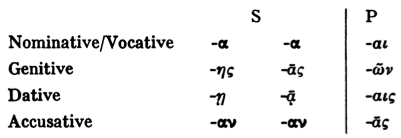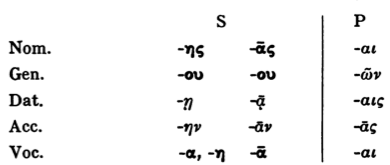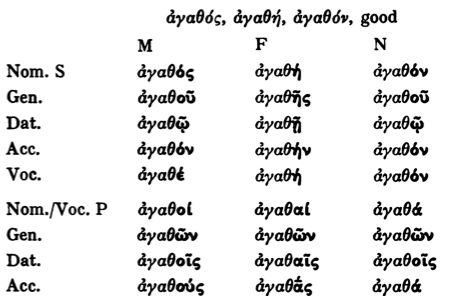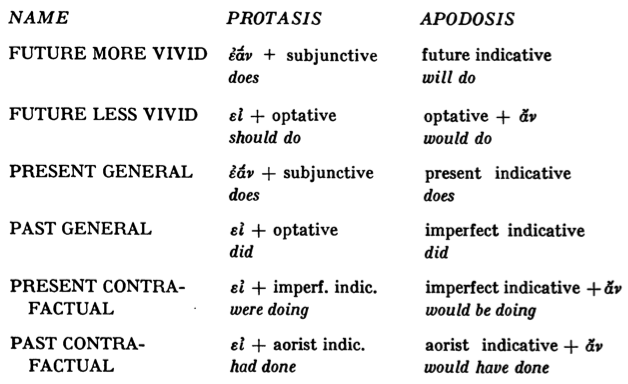Week 5: Unit 4
25/09/11 11:42
Greek Nouns and Adjectives
This week, we’ll be finishing off the first declension with some masculine forms and a hybridization of the first two paradigms we learned, and we’ll also get our first look at Greek adjectives. Finally, we get a whole new sentence type: the conditional!
First Declension in short -α
Recall that some first declension nouns have nominatives in -η and some in a long -α. A third paradigm of the first declension uses a short -α:

These forms are fairly easy to remember: they’re exactly the same as those we’ve had before, except the nominative/vocative form is a short -α. Most forms will use the first set of endings (-α, -ης, etc.), except for nouns with a stem ending in -ε, -ι, or -ρ, those will use the second set of endings. The plurals are the same for both possibilities. Here are a few examples:
θάλαττα, θαλάττης, ἡ - sea
μοῦσα, μούσης, ἡ - muse
γέφυρα, γεφύρης, - ἡ bridge
θάλαττα will follow the first set of endings (θάλαττα, θαλλάτης, θαλλάτῃ, etc.), γέφυρα the second (γέφυρα, γεφύρας, γεφύρᾳ, etc.), because it’s stem ends in -ρ.
First Declension Masculines
As I warned everyone before, some first declension nouns happen to be masculine. Luckily, they have their own paradigm of endings, so, for the most part, you won’t needlessly confuse a masculine and feminine first declension noun based on endings. For the new masculines, however, you should note that they only differ from their feminine counterparts in the genitive, dative and vocative singular. All the plurals are the same:

Just like the other paradigm we just had, if the noun stem ends in -ε, -ι, or -ρ, it will follow the second set of singular endings. Here are a few examples:
πολίτης, πολίτου, ὁ - citizen
ποιητής, ποιητού, ὁ - poet
νεανίας, νεανίου, ὁ - young man
Adjectives of the First and Second Declension
Unlike nouns, which have only one gender, adjectives have forms for every gender, depending on the gender of the noun they modify (cf. the article, which has forms for every gender, number and case). We will look at two types of adjectives: those of the first/second declension, with three sets of endings for masculine, feminine and neuter, and those called ‘double termination,’ which have two sets of endings for the masculine/feminine and neuter.
Luckily for us, the endings for the adjectives are all familiar (they’re called first/second declension adjectives for a reason). You’ll notice that we simply apply the familiar first declension endings for feminines and second declension endings for mascule/neuter nouns:

Adjective accent is persistent (given by the nominative singular form). Except for the vocative accents, these endings are exactly the same as the nouns ἀδελφός, ψύχη, and ἔργον.
Of course, when a first/second declension adjective ends in -ε, -ι, or -ρ, it will have special endings in the feminine: ἀξίος, ἀξία, ἀξίον has the following endings in the feminine singular: ἀξία, ἀξίας, ἀξίᾳ, ἀξίαν, ἀξία. For these forms, the feminine genitive plural doesn’t move the accent to the ultima, as you would expect from the first declension nouns and the regular first/second declension adjectives.
Double Termination Adjectives
Some adjectives are lazy, and don’t distinguish endings for the masculine and feminine. We call these ‘double termination’ adjectives:

Adjective and noun, just like article and noun, have to agree in gender, number and case. Because we have different types of adjectives, not just those of the first and second declension, we will often have nouns and adjectives whose endings are not identical. Check out these examples:
Plenty of adjectives will have endings that match their noun: ἀγαθὴ ψύχη - a good soul.
But often they will not match: ἄδικος ψύχη - an unjust soul. ἄδικος is a double termination adjective, and thus has similar masculine and feminine forms - ψύχη is feminine, nominative singular and so is ἄδικὸς.
Adjective Position
We are already familiar with attributive position, the placement of an adjective, prepositional phrase, or genitive between the article and noun or after a repeated article:
ὁ ἀγαθὸς ἄνθροπος - the good man
ὁ ἄνθροπος ὁ ἀγαθός - the good man
ἄνθροπος ὁ ἀγαθός - the good man
An adjective can also be in what’s called the predicate position. This placement essentially turns a pair of nouns or a noun and a qualifying adjective into a complete sentence, with the verb ‘to be’ gapped out (i.e., not included).
ὁ ἄνθροπος ἀγαθός - The man is good.
ἀγαθὸς ὁ ἄνθροπος - The man is good.
τό βιβλίον δῶρον - The book is a gift.
δῶρον τό βιβλίον - The book is a gift (this order emphasizes the fact that the book is a gift).
Conditional Sentences
Like English, Greek can render a sentence based entirely on an assumption and the result of that assumption, called a ‘conditional’ in grammar texts and simply an ‘If…then’ sentence in common parlance. The ‘if’ part of the sentence is called the protasis, and the ‘then’ part of the sentence is called the apodosis - this is important as the (just like English) the ‘if’ part can come first or second, as can the ‘then’ part, and we need to be specific as to which part of the sentence we’re referring.
Conditionals are popular in both languages, as illustrated by American popular culture:
‘If you’re having girl problems, I feel bad for you son.’
‘If you liked it then you should have put a ring on it.’
‘If I had a million dollars...’
There are six grammatical types of conditions, and as I explain them I will give you the formulae for the protasis and apodosis, as well as a translation formula.
(1) Future more vivid Conditional
Protasis: ἐάν (if) + subjunctive
Apodosis: future indicative
Translation: does______ / will ______

This is about as simple as they get. You can adjust aspect by choosing an aorist (simple aspect) or present (continuous aspect) verb in the protasis. This applies to all subsequent examples.
(2) Future less vivid
Protasis: εἰ (if) + optative
Apodosis: optative + ἄν (not translated)
Translation: should ______ / would ______

Like FMV, the FLV condition makes an assumption about the future, but has little faith in the likelihood of that outcome happening.
(3) Present general
Protasis: ἐάν (if) + subjunctive
Apodosis: present indicative
Translation: ______s / ______s

The present general follows the conclusion that the apodosis happens as a general rule of the assumption found in the protasis. Don’t confuse a Present general condition with a FMV, which has the same protasis. You have to look at both the protasis and the apodosis to correctly translate a conditional.
(4) Past general
Protasis: εἰ (if) + optative
Apodosis: imperfect indicative
Translation: did ______ / did ______

This is the present general condition, but set in past time: the apodosis follows a conclusion that happens as a general rule of the protasis, but the whole thing is set int he past.
(5) Present contrafactual
Protasis: εἰ (if) + imperfect indicative
Apodosis: imperfect indicative + ἄν (not translated)
Translation: were ______ing / would be ______ing

In a present contrafactual, the protasis makes an assumption which the speaker knows to be untrue in present time. The apodosis draws a conclusion based on this unreal assumption.
(6) Past contrafactual
Protasis: εἰ (if) + aorist indicative
Apodosis: aorist indicative + ἄν (not translated)
Translation: had ______ed / would have ______ed

Here the assumption in the protasis is know to be false in past time - the apodosis draws a conclusion based on the unreal assumption.
Here is the chart from pg. 97 of your text summarizing the possible conditionals. If you want to get full credit for correctly translating a conditional sentence, you should spend some time alone with these forms:

This week, we’ll be finishing off the first declension with some masculine forms and a hybridization of the first two paradigms we learned, and we’ll also get our first look at Greek adjectives. Finally, we get a whole new sentence type: the conditional!
First Declension in short -α
Recall that some first declension nouns have nominatives in -η and some in a long -α. A third paradigm of the first declension uses a short -α:

These forms are fairly easy to remember: they’re exactly the same as those we’ve had before, except the nominative/vocative form is a short -α. Most forms will use the first set of endings (-α, -ης, etc.), except for nouns with a stem ending in -ε, -ι, or -ρ, those will use the second set of endings. The plurals are the same for both possibilities. Here are a few examples:
θάλαττα, θαλάττης, ἡ - sea
μοῦσα, μούσης, ἡ - muse
γέφυρα, γεφύρης, - ἡ bridge
θάλαττα will follow the first set of endings (θάλαττα, θαλλάτης, θαλλάτῃ, etc.), γέφυρα the second (γέφυρα, γεφύρας, γεφύρᾳ, etc.), because it’s stem ends in -ρ.
First Declension Masculines
As I warned everyone before, some first declension nouns happen to be masculine. Luckily, they have their own paradigm of endings, so, for the most part, you won’t needlessly confuse a masculine and feminine first declension noun based on endings. For the new masculines, however, you should note that they only differ from their feminine counterparts in the genitive, dative and vocative singular. All the plurals are the same:

Just like the other paradigm we just had, if the noun stem ends in -ε, -ι, or -ρ, it will follow the second set of singular endings. Here are a few examples:
πολίτης, πολίτου, ὁ - citizen
ποιητής, ποιητού, ὁ - poet
νεανίας, νεανίου, ὁ - young man
Adjectives of the First and Second Declension
Unlike nouns, which have only one gender, adjectives have forms for every gender, depending on the gender of the noun they modify (cf. the article, which has forms for every gender, number and case). We will look at two types of adjectives: those of the first/second declension, with three sets of endings for masculine, feminine and neuter, and those called ‘double termination,’ which have two sets of endings for the masculine/feminine and neuter.
Luckily for us, the endings for the adjectives are all familiar (they’re called first/second declension adjectives for a reason). You’ll notice that we simply apply the familiar first declension endings for feminines and second declension endings for mascule/neuter nouns:

Adjective accent is persistent (given by the nominative singular form). Except for the vocative accents, these endings are exactly the same as the nouns ἀδελφός, ψύχη, and ἔργον.
Of course, when a first/second declension adjective ends in -ε, -ι, or -ρ, it will have special endings in the feminine: ἀξίος, ἀξία, ἀξίον has the following endings in the feminine singular: ἀξία, ἀξίας, ἀξίᾳ, ἀξίαν, ἀξία. For these forms, the feminine genitive plural doesn’t move the accent to the ultima, as you would expect from the first declension nouns and the regular first/second declension adjectives.
Double Termination Adjectives
Some adjectives are lazy, and don’t distinguish endings for the masculine and feminine. We call these ‘double termination’ adjectives:

Adjective and noun, just like article and noun, have to agree in gender, number and case. Because we have different types of adjectives, not just those of the first and second declension, we will often have nouns and adjectives whose endings are not identical. Check out these examples:
Plenty of adjectives will have endings that match their noun: ἀγαθὴ ψύχη - a good soul.
But often they will not match: ἄδικος ψύχη - an unjust soul. ἄδικος is a double termination adjective, and thus has similar masculine and feminine forms - ψύχη is feminine, nominative singular and so is ἄδικὸς.
Adjective Position
We are already familiar with attributive position, the placement of an adjective, prepositional phrase, or genitive between the article and noun or after a repeated article:
ὁ ἀγαθὸς ἄνθροπος - the good man
ὁ ἄνθροπος ὁ ἀγαθός - the good man
ἄνθροπος ὁ ἀγαθός - the good man
An adjective can also be in what’s called the predicate position. This placement essentially turns a pair of nouns or a noun and a qualifying adjective into a complete sentence, with the verb ‘to be’ gapped out (i.e., not included).
ὁ ἄνθροπος ἀγαθός - The man is good.
ἀγαθὸς ὁ ἄνθροπος - The man is good.
τό βιβλίον δῶρον - The book is a gift.
δῶρον τό βιβλίον - The book is a gift (this order emphasizes the fact that the book is a gift).
Conditional Sentences
Like English, Greek can render a sentence based entirely on an assumption and the result of that assumption, called a ‘conditional’ in grammar texts and simply an ‘If…then’ sentence in common parlance. The ‘if’ part of the sentence is called the protasis, and the ‘then’ part of the sentence is called the apodosis - this is important as the (just like English) the ‘if’ part can come first or second, as can the ‘then’ part, and we need to be specific as to which part of the sentence we’re referring.
Conditionals are popular in both languages, as illustrated by American popular culture:
‘If you’re having girl problems, I feel bad for you son.’
‘If you liked it then you should have put a ring on it.’
‘If I had a million dollars...’
There are six grammatical types of conditions, and as I explain them I will give you the formulae for the protasis and apodosis, as well as a translation formula.
(1) Future more vivid Conditional
Protasis: ἐάν (if) + subjunctive
Apodosis: future indicative
Translation: does______ / will ______

This is about as simple as they get. You can adjust aspect by choosing an aorist (simple aspect) or present (continuous aspect) verb in the protasis. This applies to all subsequent examples.
(2) Future less vivid
Protasis: εἰ (if) + optative
Apodosis: optative + ἄν (not translated)
Translation: should ______ / would ______

Like FMV, the FLV condition makes an assumption about the future, but has little faith in the likelihood of that outcome happening.
(3) Present general
Protasis: ἐάν (if) + subjunctive
Apodosis: present indicative
Translation: ______s / ______s

The present general follows the conclusion that the apodosis happens as a general rule of the assumption found in the protasis. Don’t confuse a Present general condition with a FMV, which has the same protasis. You have to look at both the protasis and the apodosis to correctly translate a conditional.
(4) Past general
Protasis: εἰ (if) + optative
Apodosis: imperfect indicative
Translation: did ______ / did ______

This is the present general condition, but set in past time: the apodosis follows a conclusion that happens as a general rule of the protasis, but the whole thing is set int he past.
(5) Present contrafactual
Protasis: εἰ (if) + imperfect indicative
Apodosis: imperfect indicative + ἄν (not translated)
Translation: were ______ing / would be ______ing

In a present contrafactual, the protasis makes an assumption which the speaker knows to be untrue in present time. The apodosis draws a conclusion based on this unreal assumption.
(6) Past contrafactual
Protasis: εἰ (if) + aorist indicative
Apodosis: aorist indicative + ἄν (not translated)
Translation: had ______ed / would have ______ed

Here the assumption in the protasis is know to be false in past time - the apodosis draws a conclusion based on the unreal assumption.
Here is the chart from pg. 97 of your text summarizing the possible conditionals. If you want to get full credit for correctly translating a conditional sentence, you should spend some time alone with these forms:
